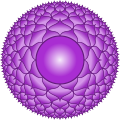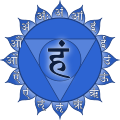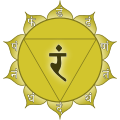Chakra

Chakras (from Sanskrit: m., चक्र cakra, [ʧʌkɽʌ], literally: "wheel, discus, circle"), are organs of the astral body respectively soul organs which serve the perception of the soul world. They are also called lotus flowers, derived from the sacred Indian lotus (Nelumbo nucifera), because they show themselves to the clairvoyant gaze in a circular, flower-like form, which justifies their name. In modern man they stand still, but can be set in motion through spiritual training. In the advanced clairvoyant they rotate clockwise and thus open up to him the view into the spiritual world. Modern clairvoyance is associated with strict thought control.
In the Atlantean age, the lotus flowers were still mobile, in the Lemurian period they even moved very violently, but turned counterclockwise. This is also the case with today's mediums with atavistic clairvoyance. The clairvoyance of mediums, however, is an unconscious one that is not subject to thought control (Lit.:GA 94, p. 173).
Chakra or Sudarshana Chakra (Sanskrit: सुदर्शन चक्र sudarśana cakra, roughly: "easily visible wheel" or "auspicious wheel") is also the name given to the throwing disc of the Hindu god Vishnu, which, along with the mace (gada), the conch shell (shankha) and the lotus (padma), is one of his four essential insignia. Based on the Rigveda, in Hinduism, Buddhism and Sikhism the spinning disk is considered a symbol of the wheel of time, for time running in recurring cycles, also called Kalachakra[1].
The system of the seven main chakras
There are seven main chakras and, in addition, numerous secondary chakras, e.g. in the hands, in which the 7 main chakras are reflected in a special way. The entire, closely interconnected system of main and minor chakras forms the so-called lotus tree. It corresponds to the Bodhi tree under which the Buddha received his enlightenment, but also to the fig tree cursed by Christ, which was meant to indicate that the time of atavistic clairvoyance has expired. The Prophet Muhammad also received his revelation through the Archangel Gabriel "Near Sidrat al-Muntaha (a lote tree of the utmost boundary over the seventh heaven beyond which none can pass)" (Quran 53:13-14)
Main chakras

1. Muladhara
2. Svadhisthana
3. Nabhi-Manipura
4. Anahata
5. Vishuddhi
6. Ajna
7. Sahasrara.
In his lectures "Popular Occultism" (Lit.:GA 94, p. 129ff) Rudolf Steiner described the system of the seven main chakras as follows:
„Seven such astral organs are distinguished. The first, the two-petalled lotus, is in the region of the root of the nose; the second, the sixteen-petalled, is at the level of the larynx; the third, the twelve-petalled, at the level of the heart; the fourth, the eight to ten-petalled, near the navel; the fifth, the six-petalled, a little lower down; the sixth, the four-petalled, still lower down, the swastika, which is connected with all that is fertilisation; the seventh cannot readily be spoken of. These six organs have the same significance for the soul world as the physical senses have for the perception of the sense world. An image of this is the so-called swastika. Through the above-mentioned exercises they first become lighter, then they begin to move. In today's man they are immobile, in the Atlantean they were still mobile, in the Lemurian they were still very lively. But they turned in the opposite direction then than they do today in the occultly evolved, where they turn clockwise. An analogy to the dreamlike clairvoyant state of the Lemurians is the fact that even in the mediums of today with atavistic clairvoyance the lotuses still turn in the direction as they once did in the Atlantean and Lemurian times, namely, counter-clockwise. The clairvoyance of mediums is an unconscious one, without thought-control, but that of the genuine clairvoyant is conscious and closely supervised by thought. The mediumship is very dangerous, but the healthy secret training is entirely harmless.“ (Lit.:GA 94, p. 173)
In oriental tradition the seventh lotus flower, of which Rudolf Steiner does not speak further here, is largely unanimously called the thousand-petalled lotus flower. It is located as the parietal chakra near the pineal gland. Its activity is revealed in the head aura of the human being, in the halo.
„One should not think of these organs as something that has an imprint of its reality in the imagination of its sensual image. These organs are precisely supersensuous and consist in a definite soul-activity; and they exist only in so far and so long as this soul-activity is practised. Something that can be seen as sensuous is as little in man with these organs as there is some "vapour" around him when he thinks. Whoever wants to imagine the supersensible in a thoroughly sensuous way gets into misunderstandings.“ (Lit.:GA 13, p. 345)
Not of Indian origin is the assignment of the rainbow colours to the chakras, which was only introduced in 1927 by Charles W. Leadbeater in his book "The Chakras".
Hand chakras
The hand chakras are important secondary chakras. On the one hand, they enable the seven main chakras to radiate their special qualities in a very differentiated way, on the other hand, they can also receive fine impulses from outside and make them perceptible. As far as is known, there is no information from Rudolf Steiner as to how the seven main chakras are reflected on the inner surfaces of the hands. It is generally assumed that the root chakra is mainly expressed on the inside of the wrist, and the crown chakra in the middle of the palm. The remaining 5 chakras are usually roughly assigned to the five fingers, although not always in a consistent manner. This is hardly surprising, as the chakra system is actually much more differentiated. Each finger receives effects from all 7 main chakras, of which it expresses one more and others less depending on the situation. A rigid classification does not do justice to the living essence of the hands, which is why this is also dispensed with here.
The hands of the human being are in the process of ascending development. They are destined to become new organs of thought on the New Jupiter (Lit.:GA 156, p. 80ff). Already today they are exceedingly fine sensitive organs of feeling. Frequent hand washing promotes this subtle sensitivity of the hands. Furthermore, they are also subtle organs of thought for destiny, karma (Lit.:GA 181, p. 94ff).
To the clairvoyant gaze, the hands appear as particularly wonderful entities. They emit etheric radiations through the fingers, the back of the hand and especially through the inner surfaces of the hands, which can have an invigorating, healing effect in people with a correspondingly high spiritual development. The hand chakras also play an essential role in this. This is the real basis of blessing and laying on of hands.
Foot chakras
The foot chakras reflect all seven main chakras on the soles of the feet in a similar way to the hand chakras on the inner surfaces of the hands, for example the root chakra in the heel area, the heart chakra in the middle of the sole of the foot and the crown chakra in the upper toe area.
The chakras and the etheric forebone
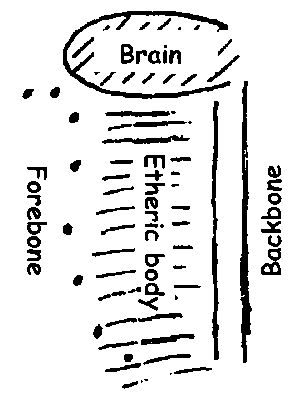
The etheric forebone, occasionally also called the elementary backbone by Rudolf Steiner (Lit.:GA 147, p. 65f), is an etheric organ which will in future be formed at the front of the human being as a counterpart and complement to the backbone, with which it will later combine to form a closed system. It thus forms a kind of second, though purely etheric, spinal column. Through spiritual training, if it is done in the right way, this development is already anticipated to a certain extent today (Lit.:GA 266b, p. 119).
The etheric forebone, which descends in front from the head, is organised by the joint activity of the pineal (epiphysis cerebri) and pituitary gland (hypophysis) and already announces itself today in the chain of chakras, which, however, are not etheric but astral organs. These soul organs, which are formed and activated in the astral body through meditation, push themselves off in the etheric body and thus gradually form the forebone. It lies behind the breastbone, which, however, man will no longer have in the 7th post-Atlantean age, when the forebone reaches maturity. (Lit.:GA 224, p. 40f)
Importance of moral development
If moral development is insufficient, the elementary backbone and the system of the chakras very easily become a point of attack for the adversary powers. The Luciferic powers push in more from the outside and seize the astral system of the chakras, while the Ahrimanic powers seize the etheric forebone. The system of the chakras is thus constricted with the etheric forebone and man is, as it were, bound within himself. Thereby a degree of egoism, lust for power and love of deception is formed which is quite unthinkable if man remains firmly in the physical world without spiritual training.
„Just as it has already been mentioned that that which - developed in a spiritual way - can lead to high virtues in the spiritual world, if allowed to flow down into the sense world, can lead to the strongest vices, so it is also with regard to the chakras and the elementary backbone. It is also possible to awaken the chakras and the elementary spine by certain actions without seeking moral firmness, but no conscientious clairvoyant will recommend this. The moment one crosses the threshold to the spiritual world, one comes close to the Luciferic and Ahrimanic beings in quite a different way from the way one encounters them in the physical-sensual world. And one experiences the peculiar thing, as soon as one has crossed the threshold, that is, as soon as one has lotus flowers and a backbone, that one immediately sees the Luciferic powers approaching. These have the ambition to seize the leaves of the lotus flowers. They stretch out their tentacles towards our lotus blossoms, and one must have developed in the right way so that one uses these lotus blossoms to grasp spiritual processes and that they are not grasped by Luciferic powers. But this is only possible if one ascends into the spiritual world with the fortification of the moral forces. I have already indicated that in the physical-sensuous world the ahrimanic forces approach man more from without, the luciferic forces more from within the soul. In the spiritual world it is the other way round: there the Luciferic beings come from without and want to seize the lotus flowers, and the Ahrimanic beings come from within and establish themselves in the elementary backbone. And now, if one has not ascended in morality into the spiritual world, the ahrimanic and the luciferic powers form a strange alliance with each other. If one has ascended with ambition, vanity, with a lust for power, with pride, then Ahriman and Lucifer succeed in making a covenant with each other. I will use an image for what Lucifer and Ahriman do, but this image corresponds to reality. Lucifer and Ahriman tie the leaves of the lotus flowers to the elemental backbone. All the leaves of the lotuses are tied together with the elemental backbone, man is tied up in himself, bound up in himself by his developed lotuses and by his elementary backbone. And the result is that a degree of egoism and degree of love of delusion enters which are quite unthinkable when man merely stands still in the physical world.“ (Lit.:GA 147, p. 65f)
The formation of the etheric fore-bone is related to the process of memory formation. This is based on the fact that, on the one hand, a stream of etherised blood flows up from the heart and plays around the pineal gland, which now emits these forces like fine rays of light. On the other hand, a second etheric current flows upwards with the lymph fluid from the lower organism to the hypophysis. Memory is formed by balancing the tension between these two currents and absorbing what is to be remembered into the depths of the organism. This also applies to those forces that are stored up in the organs for the next incarnation. In conventional memory formation, what is first imprinted on the etheric body is passed on to the physical body. This does not happen with spiritual training. All the forces remain in the etheric body, are strengthened and thus make the etheric body a suitable living organ of reflection through which the experiences of the chakras can become conscious.
The chakras as spiritual organs of perception
„The spiritual-soul organs, the lotus flowers, are formed in such a way that they appear to the supersensible consciousness in the person undergoing training as if they were near certain physical bodily organs. From the series of these soul organs, the following should be mentioned here: the one that is felt as if near the centre of the eyebrow (the so-called two-petalled lotus flower), the one in the region of the larynx (the sixteen-petalled lotus flower), the third in the region of the heart (the twelve-petalled lotus flower), the fourth in the region of the pit of the stomach. Other such organs appear near other physical parts of the body. (The names "two-" or "sixteen-petalled" can be used because the organs in question can be compared to flowers with the corresponding number of petals).
The lotus flowers become conscious in the astral body. At the moment when one has developed one or the other, one also knows that one has it. One feels that one can use them and that through their use one really enters a higher world. The impressions one receives from this world are in some respects still similar to those of the physical-sensual world. He who recognises imaginatively will be able to speak of the new higher world in such a way that he describes the impressions as sensations of warmth or cold, perceptions of sound or words, effects of light or colour. For he experiences them as such. But he is aware that these perceptions express something different in the imaginative world from what they do in the sensuous and real world. He recognises that behind them there are not physical-material causes, but spiritual-spiritual causes. If he has something like an impression of warmth, he does not, for example, attribute it to a hot piece of iron, but he regards it as the outflow of a mental process such as he has hitherto known only in his inner mental life. He knows that behind the imaginative perceptions there are spiritual things and processes, just as behind the physical perceptions there are material-physical beings and facts. - In addition to this similarity between the imaginative and the physical world, however, there is a significant difference. There is something in the physical world that appears quite differently in the imaginative. In the physical world, we can observe a continual coming into being and passing away of things, an alternation of birth and death. In the imaginative world, a continuous transformation of one into the other takes the place of this appearance. For example, in the physical world one sees a plant perish. In the imaginative world, to the same extent that the plant withers away, the emergence of another form appears, which is physically imperceptible and into which the dying plant gradually transforms itself. When the plant has disappeared, this structure is fully developed in its place. Birth and death are concepts that lose their meaning in the imaginative world. In their place comes the concept of the transformation of one into the other. - Because this is so, those truths about the essence of man which have been communicated in this book in the chapter "Essence of Humanity" become accessible for imaginative cognition. For physical-sensual perception only the processes of the physical body are perceptible. They take place in the "area of birth and death". The other members of human nature: the life body, the sentient body and the I are subject to the law of transformation, and their perception is opened up to imaginative cognition. He who has advanced to this realisation perceives how that which lives on with death in a different mode of existence dissolves, as it were, out of the physical body.“ (Lit.:GA 13, p. 258ff)
Just as physical sense organs are necessary for sensual perception, spiritual perception requires soul organs of perception. In humanity's present state of development, they are not active during our earthly life. When the human being discards his physical body - and thus also his physical senses - with death, they begin to awaken. However, they can also be put into activity during our earthly existence through specific spiritual training:
„These organs are the seven lotus flowers, chakras. Thus, at the root of the nose, between the eyebrows, the two-petalled lotus flower is formed. Clairvoyant artists have known this and given their works of art the symbol for it: Michelangelo formed his "Moses" with two horns. The lotus flowers are distributed in the following way:
- the sixteen-petalled lotus flower near the larynx,
- the twelve-petalled lotus near the heart,
- the eight- or ten-petalled lotus near the pit of the stomach,
- a six- and a four-petalled one are further down.
These astral organs can hardly be seen in the ordinary man of today, but when he becomes clairvoyant, or in a state of trance, they stand out sharply in vivid, luminous colours and move.
The moment the lotus flowers move, man perceives in the astral world. The difference between physical and astral organs is that the physical sense organs of man are passive; they allow everything to act upon them from outside. The eye, ear and so on are at first in a state of rest, they have to wait until something is offered to them, light, sounds and so on. The mental organs, on the contrary, are active, they embrace the object like a clamp. But this activity can only awaken when the powers of the astral body are not needed elsewhere; then, however, they flow into the lotus flowers. Even in Kamaloka, as long as the lower parts of the astral body are still connected with the human being, an opacity still takes place. But when the astral corpse is cast off and only that which is permanently acquired remains, that is, at the gate of Devachan, then these astral sense organs are awakened to full activity, and in Devachan man lives to a high degree consciously with these sense organs.“ (Lit.:GA 95, p. 42f)
The same astral forces that refresh the physical body and the etheric body during the night in sleep are used by the spiritual disciple to train and activate his astral sense organs. To do this, he draws parts of these powers from his lower bodily members and transforms them into spiritual organs of perception. He will only be successful if he gives his whole life a rhythmic course. Rhythm saves strength!
„When man has attained this devachanic state, then the lotus flowers, the chakras or wheels, at certain points in the astral body begin to turn from left to right like the hand of a clock. They are the sense organs of the astral body, but their perception is an active one. The eye, for example, is at rest, it lets the light come into it and then perceives it. The lotus flowers, on the other hand, only perceive when they move, when they embrace an object. The vibrations excited by the turning of the lotus flowers then cause astral matter to be touched, and thus perception arises on the astral plane.
Now, what are the forces that the lotus flowers form? Where do these forces come from? We know that during sleep the exhausted powers of the physical and etheric bodies are replaced by the astral body; through its regularity it can compensate for irregularities of the physical and etheric body during sleep. But it is these powers, which are used to overcome fatigue, that form the lotus flowers. A human being who begins his occult development thus actually withdraws forces from his physical and etheric body. If these forces were to be permanently withdrawn from the physical body, the human being would have to fall ill, indeed, complete exhaustion would set in. If he does not want to harm himself physically and morally, he must replace these powers with something else.
One must remember a general rule of the world: rhythm replaces strength! This is an important occult principle. Today man lives most irregularly, especially in imagination and action. A man who merely allowed the distracting outer world to have an effect on him and joined in, could not escape this danger into which his physical body is plunged by the occult development because of the withdrawal of strength. Therefore man must work to bring rhythm into his life. Of course he cannot arrange it so that one day runs like the other. But there is one thing he can do: he can carry out certain activities quite regularly, and this is what he who is undergoing occult development must do. For example, he should perform meditation and concentration exercises every morning at a time fixed by himself. Rhythm also comes into his life through an evening review of the day. If one can then introduce other regularities, this is all the better, because in this way everything runs according to the world laws, so to speak. The whole world system runs rhythmically. Everything in nature is rhythm: the course of the sun, the course of the seasons, of day and night and so on. Plants grow rhythmically. However, the higher we climb, the less the rhythm becomes apparent, but even in animals we can still perceive a certain rhythm. The animal, for example, still mates at regular times. Only man enters into an unrhythmic, chaotic life: nature has released him.
This chaotic life must now be consciously made rhythmic again, and in order to achieve this he is given certain means by which he can bring this harmony, this rhythm into his physical and etheric body. Little by little these two bodies are then set into such vibrations that they correct themselves when the astral body emerges. Even if they are driven out of rhythm during the day, they push themselves back into the right movement when at rest.“ (Lit.:GA 95, p. 111ff)
Imagination, Inspiration, Intuition
When the activity of the two-petalled lotus flower turns inwards, the capacity for external, sensual perception arises. When its "astral tentacles" turn outwards, imagination arises. Turned inwards, the sixteen-petalled lotus flower enables feeling, turned outwards, inspiration. The twelve-petalled lotus flower perceiving inwardly enables thought formation, outwardly intuition.
| inwards | outwards | lotus flower |
|---|---|---|
| sense perception, imagination | Imagination | Two-petalled lotus flower |
| Feeling | Inspiration | Sixteen-petalled lotus flower |
| Thought formation | Intuition | Twelve-petalled lotus flower |
„When you are in a position to stretch out your astral tentacles without any external cause, then that occurs which in a higher sense can be called spiritual perception. The actual spiritual organs of perception are formed. At the moment when man acquires the ability not only to push back the system of overtones with his attention[2], but when he can push out his astral substance at a certain point of the forebrain - between the eyebrows - like two tentacles, then he forms at this point what is called the two-leaved lotus flower, the first spiritual organ, what may also be called the imaginative sense.... And to the same extent as the human being becomes more and more capable and able to stretch out his astral substance out of himself, without being forced by the outside world, to the same extent he forms further higher senses. In the region of the larynx he develops through this work a very complicated sense, the sixteen-petalled lotus flower, the inspiring sense; further, in the region of the heart, the sense which may also be called the intuitive sense, the twelve-petalled lotus flower, and then still other higher senses, which, however, because one comes into the purely spiritual, can no longer be called sense in the ordinary sense. It is enough that we have to add to the physical, actual senses the imaginative sense, the inspiring sense and the intuitive sense.
Now we ask ourselves: Are these three senses only active in the clairvoyant or is there also something in the ordinary human being which he can understand as an activity of these senses? - Yes, even in the ordinary human being there is something that can be understood as an activity of these senses, the imaginative, the inspiring and the intuitive sense. If you have understood exactly how these senses work in the clairvoyant, you will say to yourself that they work by extending outwards like tentacles. In the ordinary human being they are also present, with the only difference that they do not extend outwards but inwards. Exactly at the point where the two-petalled lotus flower arises in the clairvoyant, there is in the ordinary human being something like two such tentacles which go inwards, crossing only in the region of the forebrain. So the ordinary consciousness simply turns these tentacles inwards instead of outwards as in the clairvoyant.
I can only make clear to you what is here by means of a comparison. You would have to meditate a lot if you wanted to get beyond the comparison to the fact. For it is a fact. You need only realise that man sees what he has outside himself and does not see what he has within himself. No one has yet seen his own heart or brain. It is the same in the spiritual. Not only are the organs not seen, but they are not conscious, and therefore they cannot be used. But they work. The fact that something is not conscious does not make it inactive. Consciousness does not decide about reality. Otherwise, everything that is around us in this city of Berlin and that you do not see now would not have to be there. However, this is a logic according to which those go who deny the higher worlds because they do not see them. These senses are active, but their activity is directed inwards. And it is this inward effect of activity that man now perceives. How does he perceive it? As the imaginative sense pours inwards, what in ordinary life is called the sensation of some thing arises, the outer sensation, the outer perception. The fact that you see things outside is due to the fact that this sense works inside. What you have on the outside as a sensation, as a perception, you can have only through that which works into you which comes to light in the imaginative sense. But you must distinguish between what is called sensation here and what is, for example, a sound. It is something else to hear a sound, to see a colour or to have a sensation. To see a colour and say it is red is something different from having the sensation with it: it is beautiful or ugly, pleasant or unpleasant in the immediate impression.
The inspiring sense also pours its activity inwards, and through this activity arises what is now a more complicated sensation: the feeling. The whole life of feeling, which has more inwardness than the mere life of sensation, is an activity of the inspiring organ, which is only active inwardly instead of outwardly. And when the intuitive sense pours inwards, then what we now actually call thinking, thought-forming, comes into being. That is the success of the inward activity of the intuitive sense. First man has a sensation of the thing, then comes the feeling, and finally he forms his thoughts about it.
With this you will have seen that we have already entered from the life of the senses into the life of the soul. From the outside, from the world of the senses, we have grasped the soul in the human being himself in sensations, in feelings, in thoughts. If we were now to go further and consider the higher senses, which we can now no longer well call senses, which correspond to the other lotuses, in their inward effect, we would find the whole higher life of the soul. If, for example, the eight-petalled or the ten-petalled lotus flower, which is situated further down in the organism, pours its activity inwards, then a still finer soul activity arises. And at the end of this series we find that very finest soul-activity which we now no longer call mere thought, but pure thought, mere logical thought. This is what is brought forth by working into the inner being of man through the various lotus flower activities.
Now, when this working in again ceases to be mere working in and, as I have indicated, begins to work out, when, therefore, those tentacles which otherwise extend inwards cross everywhere and pour outwards as lotus flowers, then that higher activity comes about through which we ascend from the soul to the spirit, where that which otherwise appears to us merely as inner life in thinking, feeling and willing now appears in the outer world, borne by spiritual entities.“ (Lit.:GA 115, p. 53ff)
The properties of particular chakras
„The spiritual sense organ, which is located near the larynx, makes it possible to clairvoyantly see through the way of thinking of another soul being, it also allows a deeper insight into the true laws of natural phenomena. - The organ in the neighbourhood of the heart opens up a clairvoyant insight into the way of thinking of other souls. Those who have trained it can also recognise certain deeper forces in animals and plants. Through the sense near the so-called pit of the stomach one gains knowledge of the abilities and talents of souls; one can see what role animals, plants, stones, metals, atmospheric phenomena and so on play in the household of nature.
The organ near the larynx has sixteen 'petals' or 'wheel spokes', that near the heart has twelve, that near the pit of the stomach ten.“ (Lit.:GA 10, p. 84)
In modern yoga, the chakras are assigned the rainbow colours, certain sounds and mantras. The assignment of the vowels corresponds to their natural seat. The heart chakra is represented either in green or in the complementary peach blossom colour.
- The 7 lotuses in traditional yoga
-
Crown Chakra
(Sahasrara)
"OM"
violet -
Brow Chakra
(Ajna)
"I"
indigo -
Throat Chakra
(Vishuddha)
"E"
blue -
Heart Chakra
(Anahata)
"A"
green or peach blossom -
Navel Chakra
(Manipura)
open "O"
yellow -
Sacral Chakra
(Svadhishthana)
closed "O"
orange -
Root Chakra
(Muladhara)
"U"
red
The chakras in the occidental tradition
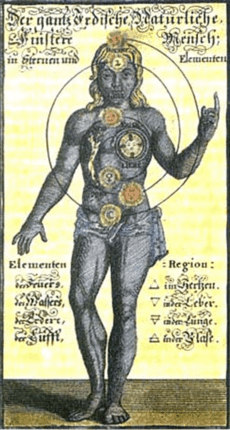
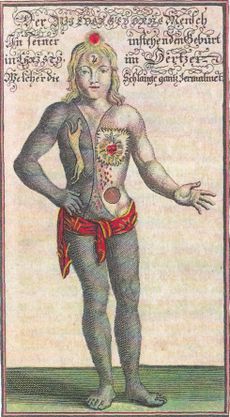
In addition, some information should be given here that is not found in Steiner's work. The knowledge of the chakras was by no means limited to the Oriental sages; the initiates in Europe also had a clear view of them, as described by Johann Georg Gichtel, a student of Jakob Böhme.
In his explanations of the inner man[2], Gichtel relates the chakras (although without referring to them as such by name) to the planetary spheres:
| Crown Chakra | Saturn | 1000-leaved |
| Brow chakra | Jupiter | 2-leaved |
| Throat chakra | Mars | 16-leaved |
| Heart Chakra | Sun | 12-leaved |
| Navel Chakra | Venus | 10-leaved |
| Sacral chakra | Mercury | 6-leaved |
| Root chakra | Moon | 4-leaved |
The number of leaves on the lotus flowers is very clearly related to planetary rhythms. The root chakra shows the four phases of the Moon, the sacral chakra the three upper and three lower conjunctions of Mercury (Mercury hexagram) and the navel chakra is based on the Venus pentagram. Incidentally, these planetary forces also play a role in the design of outer flower forms: Mercury in the six-petalled flowers (lily family) and Venus in the five-petalled flowers (rose family). In the 12-petalled heart lotus, the path of the Sun through the 12 signs of the zodiac is depicted.
Note the occult order of the planets (Moon - Mercury - Venus - Sun - Mars - Jupiter - Saturn), in which the planets Mercury and Venus are reversed compared to today's depictions according to the heliocentric system. Gichtel was obviously familiar with this occult sequence. Rudolf Steiner also pointed out this reversal of the order of Mercury and Venus several times.
Gichtel describes here the basic and natural assignment of the chakras to the planetary spheres. In fact, however, the chakras form a holistic system in which each lotus flower corresponds in some way with each planetary sphere. In certain contexts, therefore, other assignments are possible and make sense. For example, the healing love power of the Sun or the martial-active Mars power can very well be connected with the root chakra, which naturally corresponds to the lunar sphere, resulting in very different effects.
Literature
- Werner Bohm: Chakras. Lebenskräfte und Bewusstseinszentren im Menschen, Otto-Wilhelm-Barth-Vlg., München 1953
- Willi Seiß: Chakra-Werk (Sammelwerk zur Fortsetzung), Achamoth Verlag, Taisersdorf
- Rudolf Steiner: Wie erlangt man Erkenntnisse der höheren Welten?, GA 10 (1993) English: rsarchive.org German: pdf pdf(2) html mobi epub archive.org
- Rudolf Steiner: Die Geheimwissenschaft im Umriß, GA 13 (1989) English: rsarchive.org German: pdf pdf(2) html mobi epub archive.org
- Rudolf Steiner: Kosmogonie, GA 94 (1979), Leipzig, 9. Juli 1906 (Zwölfter Vortrag aus dem Zyklus Populärer Okkultismus) English: rsarchive.org German: pdf pdf(2) html mobi epub archive.org
- Rudolf Steiner: Vor dem Tore der Theosophie, GA 95 (1978) English: rsarchive.org German: pdf pdf(2) html mobi epub archive.org
- Rudolf Steiner: Anthroposophie – Psychosophie – Pneumatosophie, GA 115 (2001), ISBN 3-7274-1150-3 English: rsarchive.org German: pdf pdf(2) html mobi epub archive.org
- Rudolf Steiner: Die Geheimnisse der Schwelle, GA 147 (1997) English: rsarchive.org German: pdf pdf(2) html mobi epub archive.org
- Rudolf Steiner: Okkultes Lesen und okkultes Hören, GA 156 (1987), Vierter Vortrag, Dornach, 6. Oktober 1914 English: rsarchive.org German: pdf pdf(2) html mobi epub archive.org
- Rudolf Steiner: Erdensterben und Weltenleben, GA 181 (1967), Berlin, 12. März 1918 English: rsarchive.org German: pdf pdf(2) html mobi epub archive.org
- Rudolf Steiner: Die menschliche Seele in ihrem Zusammenhang mit göttlich.geistigen Individualitäten. Die Verinnerlichung der Jahresfeste., GA 224 (1992) English: rsarchive.org German: pdf pdf(2) html mobi epub archive.org
- Rudolf Steiner: Aus den Inhalten der esoterischen Stunden, Band II: 1910 – 1912, GA 266/2 (1996), S 119 English: rsarchive.org German: pdf pdf(2) html mobi epub archive.org
 |
References to the work of Rudolf Steiner follow Rudolf Steiner's Collected Works (CW or GA), Rudolf Steiner Verlag, Dornach/Switzerland, unless otherwise stated.
Email: verlag@steinerverlag.com URL: www.steinerverlag.com. Index to the Complete Works of Rudolf Steiner - Aelzina Books A complete list by Volume Number and a full list of known English translations you may also find at Rudolf Steiner's Collected Works Rudolf Steiner Archive - The largest online collection of Rudolf Steiner's books, lectures and articles in English. Rudolf Steiner Audio - Recorded and Read by Dale Brunsvold steinerbooks.org - Anthroposophic Press Inc. (USA) Rudolf Steiner Handbook - Christian Karl's proven standard work for orientation in Rudolf Steiner's Collected Works for free download as PDF. |
References
- ↑ Agarwala, Vasudeva Sharana (1965). Indian Art: A history of Indian art from the earliest times up to the third century A.D, Volume 1 of Indian Art. Prithivi Prakashan. p. 101.
- ↑ Johann Georg Gichtel: Eine kurze Eröffnung und Anweisung der dreyen Principien und Welten im Menschen, 1696, 1779 google
